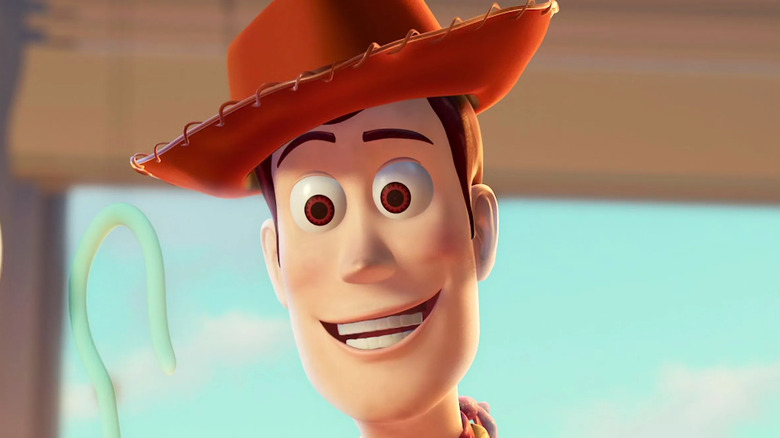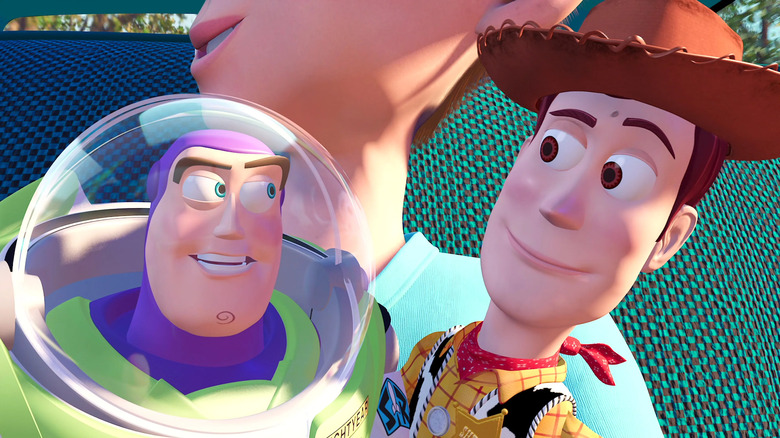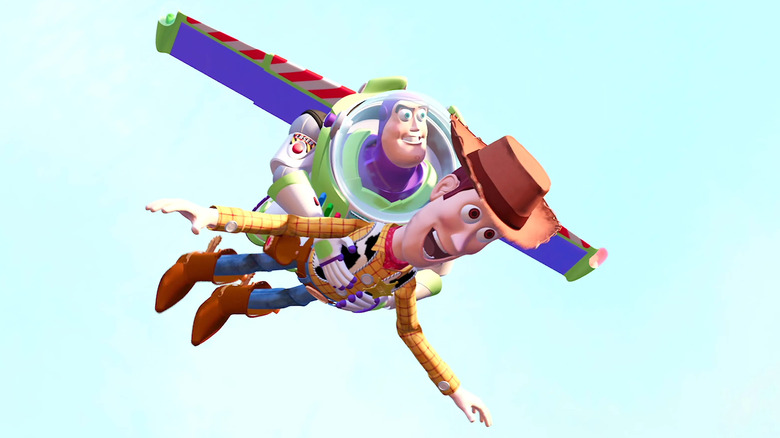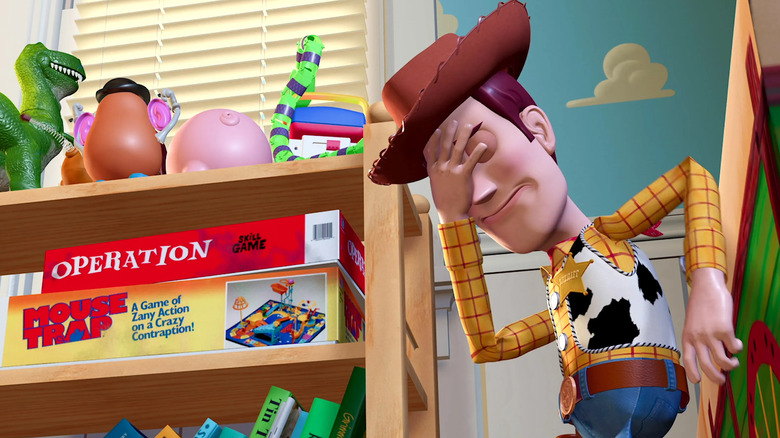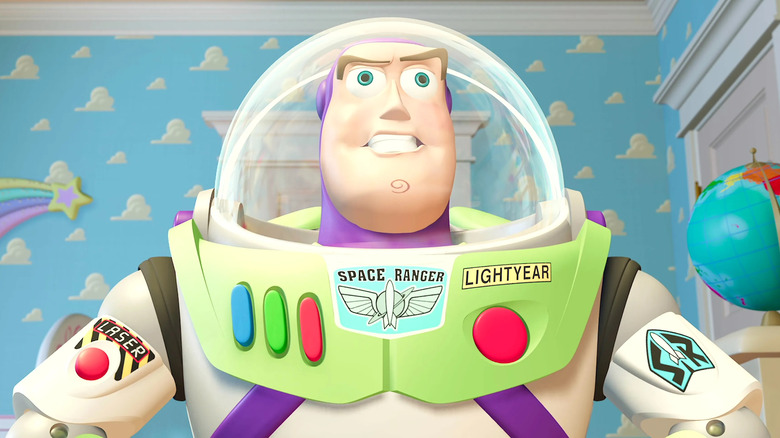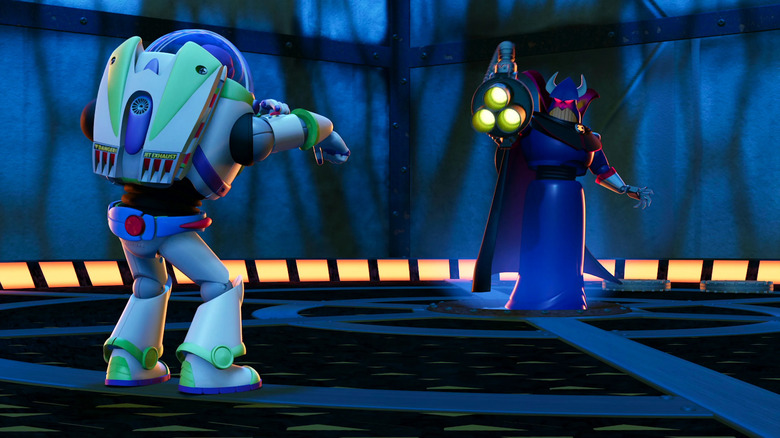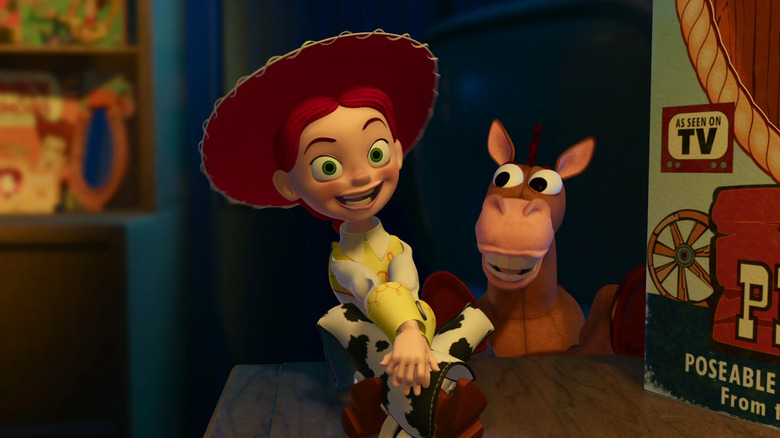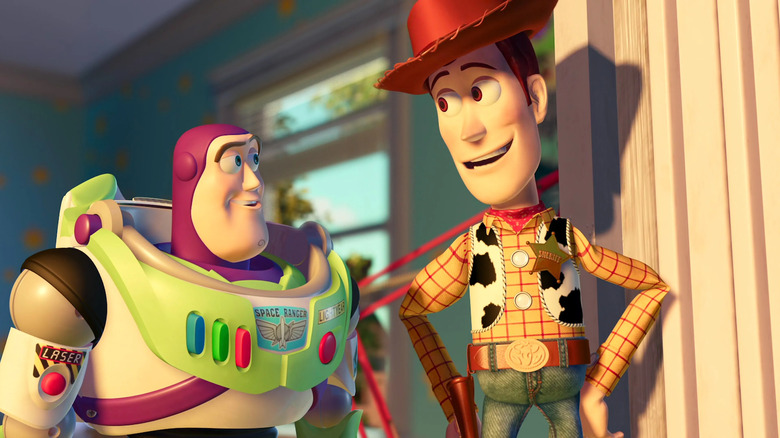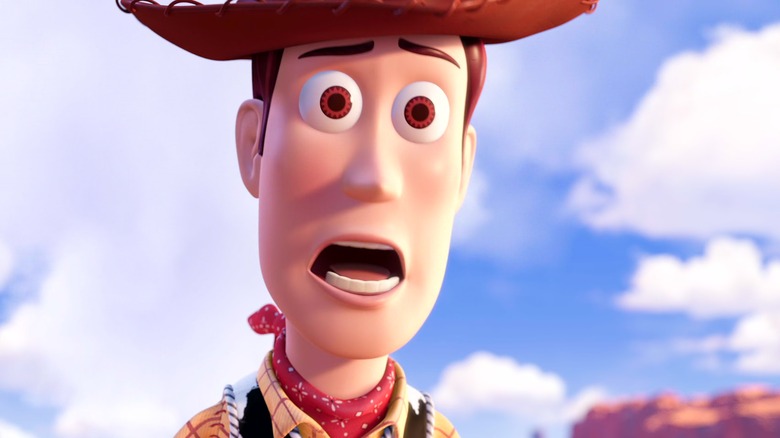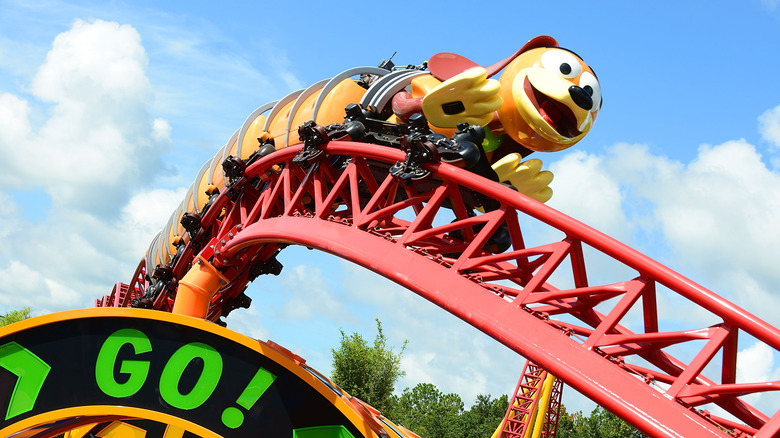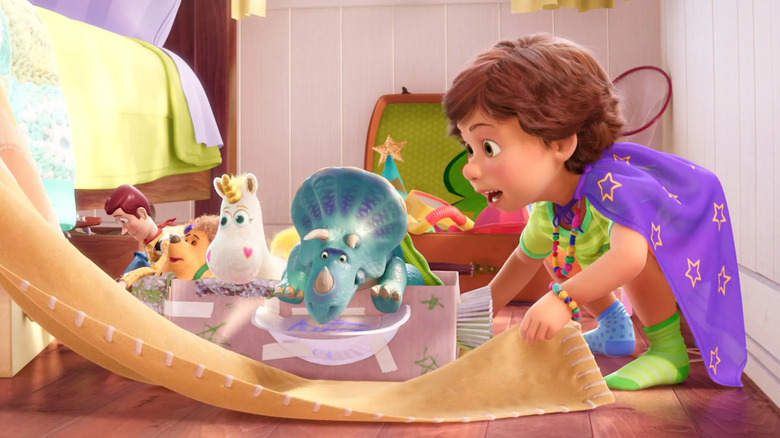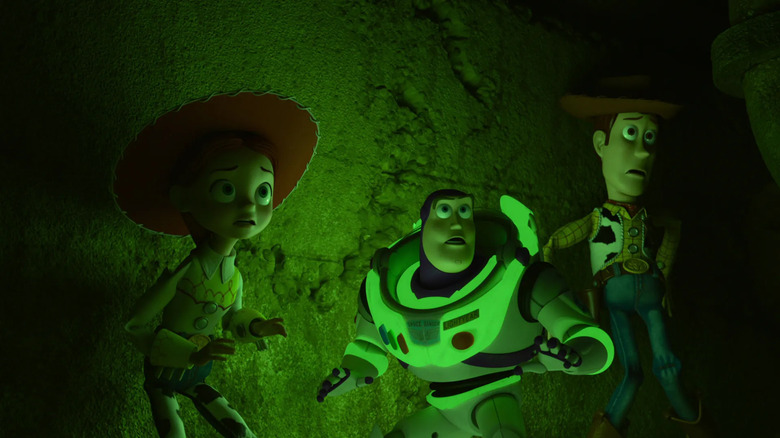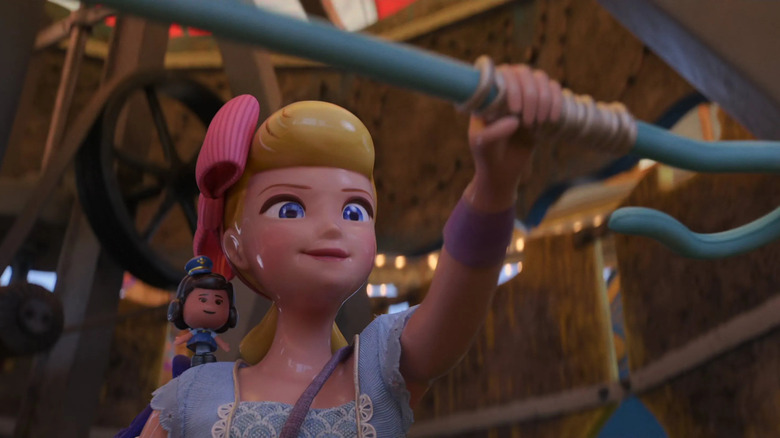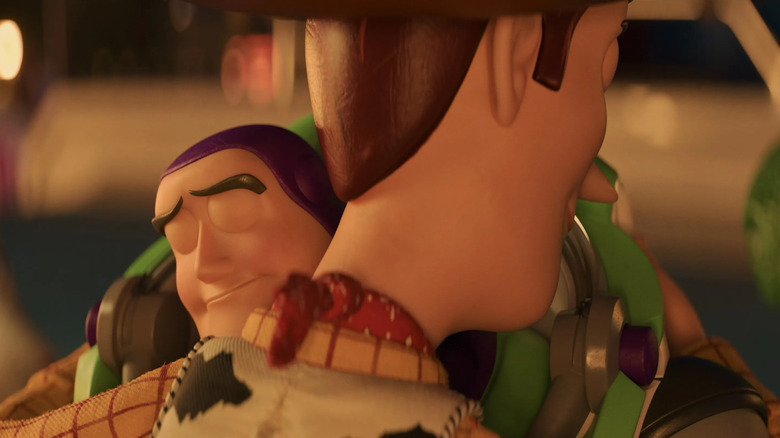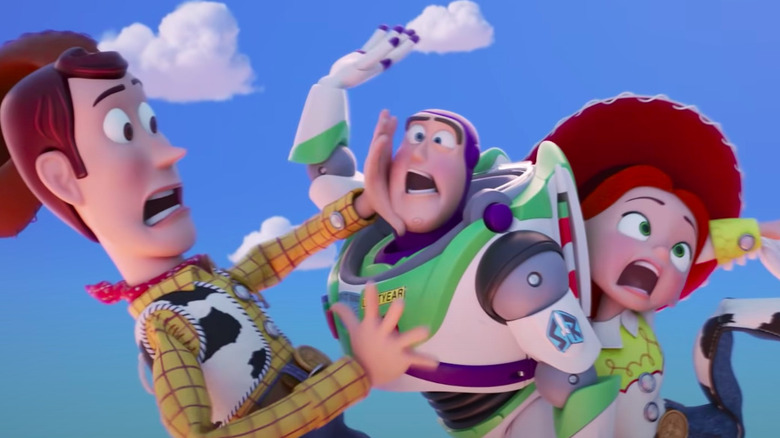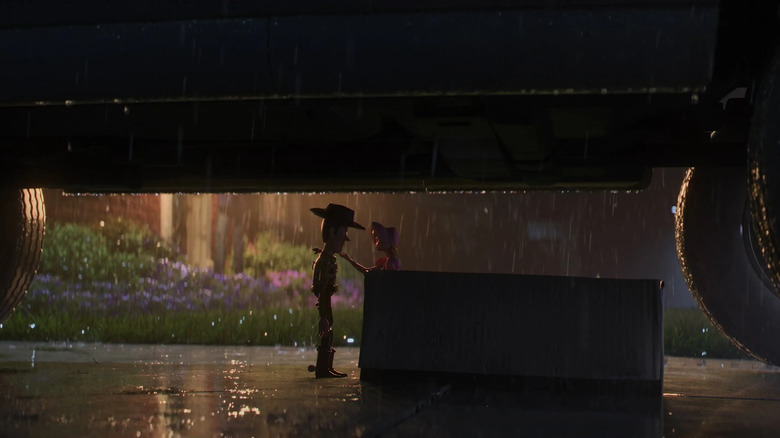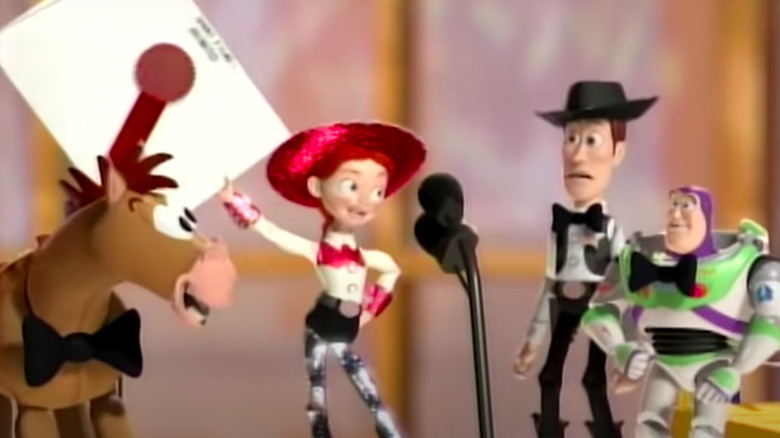The Untold Truth Of The Toy Story Franchise
Woody. Buzz Lightyear. Jessie, the yodeling cowgirl. Bo Peep. For many, these iconic names recall vivid memories attached to one of the world's most beloved film franchises, "Toy Story." "Toy Story" was not only the first full-length feature created by Pixar Animation Studios, but was also the first ever computer-animated movie, period. With its release in 1995, the original "Toy Story" laid the groundwork for a studio that would go on to change the animation industry for good, and would also begin a film series that would enthrall audiences for decades to come.
With such a storied history and four films' worth of backstage secrets, there's a lot more to the "Toy Story" movies than meets the eye. From the different versions of plots and characters that almost materialized to the surprising ways the franchise has been embraced beyond its four primary films, the legacy of "Toy Story" has withstood it all. So, hop in: We're going for a joyride in the Pizza Planet truck, with stops at Al's Toy Barn, Sunnyside Daycare, and everywhere in between. This is the untold truth of the "Toy Story" franchise.
Pixar created Toy Story by defining what it wasn't
In its early years, Pixar Animation Studios focused on making television commercials and short films (via Time). In fact, "Toy Story" marked the first move away from these areas, as it was Pixar's first full-length feature. As such, Pixar wanted to be clear about how it would differentiate "Toy Story" from the typical expectations of an animated film in the '90s.
As shared in the "Filmmakers Reflect" bonus feature on the "Toy Story" DVD, the crew made a list of qualities they did not want their movie to have. Animator and story artist Pete Docter says they wanted to eliminate "all the stuff that had become synonymous with animation in popular culture." Docter notes some of the assumptions the public had at the time around animation: "Oh, it's animated? That means it must be a musical and it must be a fairy tale." Their movie wouldn't be either.
Instead, the music of "Toy Story" would stem from non-diegetic songs written and performed by Randy Newman. Whereas most other animated movies were inspired by a classic storybook favorite, "Toy Story" would be an original, contemporary story modeled after the buddy picture formula of two adversaries becoming friends.
Although it was a Pixar movie, "Toy Story" was distributed by Disney, whose biggest animated hits at the time included "Beauty and the Beast" and "Aladdin" — movies steeped in the timelessness of their fairytale stories and bursting with Broadway-caliber songs. "Toy Story" would purposefully stray from tradition, just like Pixar intended.
Woody and Buzz weren't always a cowboy and a space toy
It's hard to imagine Woody and Buzz Lightyear as anything other than a cowboy doll and a space ranger action figure, respectively. When Pixar was first developing "Toy Story," though, Woody was originally envisioned as a ventriloquist's dummy, while Buzz was supposed to be a vintage tin toy.
The shell of the plot was the same: Buzz is the new toy in Andy's room, who becomes Andy's favorite, and Woody gets jealous of him. As Pixar filmmakers share in the "Making Toy Story" bonus feature on the "Toy Story" DVD, the more they thought about that dynamic, the more these toy choices didn't really make sense. It was animator Bud Luckey, who questioned whether Andy would really think an old wind-up toy was cool enough to become the new favorite toy. Shouldn't that toy be modern, sleek, and state-of-the-art? It was then that the character shifted to become the space ranger we know and love: "Lunar Larry." Ok, so they didn't have the name just yet. They soon changed it to ... "Tempus from Morph." All right, all right, then they switched it to "Buzz Lightyear."
With Buzz now a space-themed toy, Pixar subsequently changed Woody to a cowboy doll. This helped accentuate the difference between the two characters. On the surface, Buzz's capabilities as a toy were much more sophisticated and flashier than Woody's simplicity, which also spoke to deeper character differences between the two.
Disney wanted to shut down Toy Story after seeing the first cut
Although Pixar was the company behind the creation of "Toy Story," Disney is the one that distributed the films. As the film developed, Disney executives sent Pixar artists frequent notes about what to change, add, or remove. This led to a screening that almost changed the course of animation forever, as relayed in the documentary "The Pixar Story."
In an attempt to please their powerful distributor, the folks at Pixar listened to every single one of Disney's notes and implemented all of the suggested changes. Since this was Pixar's first movie ever, why shouldn't they take the advice of a company as experienced as Disney? However, the result was a movie that was nearly unwatchable. Dominated by executives' suggestions, which were detached from the process of storytelling, the first full cut of "Toy Story" was so disastrous that after seeing it, Disney wanted Pixar to stop making the movie.
Woody in particular didn't work as a protagonist. Thomas Schumacher (who later became president of Disney Feature Animation in 1999) recalls that the version of Woody presented in that first screening was "one of the most repelling things you've ever seen on screen." Woody was so awful and mean to Buzz that he became impossible for the audience to root for.
Pixar asked for two weeks to correct their course. Astonishingly, they turned around a revised edit in that short time that surprised everyone. By leaning into their own style, only implementing Disney's notes when they felt was appropriate, and turning Woody into a more sympathetic protagonist, Pixar changed Disney's mind. So, "Toy Story" would move forward into production.
No one thought toys from the movie would sell
Hindsight may be 20/20, but you'd really think that a company would be able to predict that a movie about toys would call for a massive merchandising opportunity of, you know, toys. But "Toy Story" was an experiment in a new type of animation that was created by a studio which had never made a movie before. Author Charles Solomon writes in his book "The Toy Story Films: An Animated Journey" that Disney wasn't sure if "Toy Story" would be a hit, and therefore wasn't very aggressive in its approach to creating merchandise for the film.
After Hasbro and Mattel both declined offers to create products based on the movie, Thinkway Toys jumped at the chance. Initial production called for 60,000 Buzz action figures and 45,000 Woody dolls, both nearly identical to their on-screen counterparts. Once "Toy Story" debuted and became a runaway hit, there was very quickly a supply/demand problem for the movie's toy line: retailers put in orders for 1.6 million Buzz orders and 1.2 million Woody orders to Thinkway. The final count of Buzzes ordered wound up at 36 million.
Thinkway's bet on Pixar paid off. Their partnership on "Toy Story" led to Thinkway becoming a global company. Ultimately, merchandise became integral to the release of each "Toy Story" film, and Thinkway Toys produced the toys all the way through 2019's "Toy Story 4."
Toy Story 2 used deleted scenes from the first film
A good idea never really goes away. So, although some sequences that were developed for "Toy Story" ended up on the cutting room floor, Pixar artists decided to use them later. Filmmakers reveal in the "Making Toy Story 2" DVD bonus feature that two scenes from the sequel were originally intended for the first film.
In "Toy Story 2," Woody has a bit of an identity crisis when he rips his arm and gets put on a shelf. He then has a nightmare about Andy throwing him away now that he's less useful. However, this moment was initially created for "Toy Story," where Woody has this nightmare because Buzz is getting all of the attention as Andy's new favorite toy in the room.
In another example, "Toy Story 2" opens with an action-packed sequence of Buzz fighting Zurg in outer space. The scene eventually unveils itself as actually being gameplay of Rex playing a Buzz Lightyear-branded video game. This idea was originally meant to be the opening sequence of "Toy Story." Instead of a video game though, the scene would have been from a cartoon that Andy watches on TV called "Buzz Lightyear: Defender of the Universe."
Toy Story 2 was a defining moment for Pixar
During the production of "Toy Story 2," Pixar learned a valuable lesson that changed the trajectory for every movie it made from that point forward. The documentary "The Pixar Story" delves into this important moment in Pixar history. "Toy Story 2" was slated for a November 1999 release date. By February 1999, however, Pixar had been developing the movie for a few years and was unhappy with how it was turning out. The studio asked the film's distributor, Disney, to change the release date, so that the filmmakers would have time to make "Toy Story 2" better. Disney wouldn't budge, claiming that they were confident in the sequel's projected success, even if its quality wasn't what Pixar wanted.
Unwilling to deliver a subpar product, Pixar did the unthinkable. Nine months before the movie's release date, the studio started over on "Toy Story 2." At that point, the first iteration of the movie was already in production and some of it was even fully animated. It didn't matter. Pixar decided that compromising quality would not be an option for the studio, so they revamped "Toy Story 2" in an unheard-of timespan. Former Pixar president Ed Catmull reflects that the Herculean feat took its toll on the crew. While the experience is not something he'd ever want to repeat, it did show the fledgling animation studio something important about their identity and reputation.
The legacy of Toy Story is what made Disney buy Pixar
The Walt Disney Company purchased Pixar Animation Studios in 2006, and in doing so, changed the animation landscape forever (via The NY Times). The moment that planted the seed for this ambitious acquisition is shared in the documentary "The Pixar Story."
Prior to 2006, all of Pixar's films had been distributed by Disney, but on a contractual basis. Disney didn't actually own Pixar, and theoretically at the expiration of every contract, Pixar could make movies for another company. In September 2005, Bob Iger, just weeks away from becoming Disney's new CEO, attended the grand opening of Hong Kong Disneyland. As he watched the park's parade, he noticed the only characters in the procession from the past 10 years' worth of movies were from "Toy Story."
Disney theme parks were where the company's most beloved stories come to life. It occurred to Iger that Pixar was doing more for Disney's legacy than Disney's own animation studio, and he began thinking about purchasing Pixar. Following this revelation in Hong Kong, Iger says, "I had a much greater sense of urgency. I became CEO October 1. I called Steve [Jobs, co-founder of Pixar] around that time." In January 2006, the deal was sealed. Disney now owned Pixar, meaning more Pixar movies and characters would be part of the Disney legacy for generations to come.
Pixar almost didn't make Toy Story 3
Prior to Disney purchasing Pixar, some murky legal clauses in the contract between the two companies began to sour their relationship. In the book "The Toy Story Films," author Charles Solomon unpacks the curious case of a "Toy Story 3" that would be made without Pixar.
Based on the agreement between Disney and Pixar, Disney had the option of using its own animation studio to make spin-offs from Pixar movies. So, Disney Television Animation produced the "Buzz Lightyear of Star Command" direct-to-DVD movie and television series in 2000. Furthermore, the contract stipulated that if Pixar didn't want to make sequels to their own movies, Disney had the right to make a sequel without the studio. This is what happened when Pixar opted out of making "Toy Story 3." Disney moved forward with the project anyway, developing it under a new animation subdivision called Circle 7. This version of "Toy Story 3" would have involved Buzz being recalled to Taiwan over a safety measure.
Andrew Stanton, co-writer of "Toy Story" and "Toy Story 2," shares, "It was really hard knowing that somewhere down south, people were — even with the best of intentions — trying to make a film that we knew would never be what we would do. The best we could hope for was that it wouldn't tarnish the memory everybody had of these characters." However, once Bob Iger became Disney's CEO and Disney acquired Pixar, Circle 7 closed and "Toy Story 3" restarted its development at Pixar with a blank slate.
Toy Story rides exist at Disney theme parks worldwide
No matter which Disney destination you visit around the globe, there's an opportunity to enter the world of "Toy Story" through a theme park ride. Some resorts even have full "Toy Story"-themed lands or hotels. In the book "Walt Disney Imagineering: A Behind the Dreams Look at Making More Magic Real," Imagineer Tom Fitzgeralds reflects on the theme park designers' relationship with Pixar: "At the end of the day, we are both storytellers, creating believable worlds in which beloved characters live, and fantastic adventures take place."
The original Disneyland in California, Disneyland Paris, and Shanghai Disneyland all boast variations of "Buzz Lightyear Astro Blasters," a laser-shooting ride set in Buzz's outer space story-within-the-story. Disneyland, Walt Disney World, and Tokyo Disneyland also include "Toy Story Midway Mania!," a shooting-style ride, which involves screens and interactivity inside larger-than-life carnival games. Walt Disney World, Hong Kong Disneyland, and Shanghai Disneyland offer the opportunity to shrink down to the size of a toy and explore Andy's backyard in different versions of "Toy Story Land."
Meanwhile, accommodations like Disney's All-Star Movies Resort in Florida and the Toy Story Hotel in both Tokyo and Shanghai continue the adoration for all things "Toy Story" beyond just the theme parks: Giant versions of beloved characters adorn the grounds and the film's art direction inspires the look of each guest room.
An unlikely comedian inspired the character of Bonnie
The filmmakers of "Toy Story 3" encountered a challenge in developing Bonnie, the little girl to whom Andy gives his toys: How would Bonnie orchestrate playtime in her room and how would that differ from Andy?
Director Lee Unkrich found unlikely inspiration in a 1977 Gilda Radner sketch from "Saturday Night Live." In the "Bonnie's Playtime" bonus feature of the "Toy Story 3" Blu-ray, Unkrich shares what appealed to him about Radner's performance and how it might inform Bonnie's personality. In the sketch, titled "The Judy Miller Show," Radner plays a little girl and imagines herself in all kinds of wacky adventures. "I just loved her exuberance," Unkrich says, "and how it was full of non-sequiturs. For me, that was the way to kick this all off."
Andy, while imaginative, creates play for his toys, with himself being a third-party storyteller. In contrast, Bonnie creates play with her toys, inserting herself into the situations she creates as an active character in the story alongside the toys. This breakthrough provided Pixar with the differentiation they were looking for.
Furthermore, when kids leave the room, the toys' dominion has a certain atmosphere. For Andy's room, that atmosphere was like an office, and the toys' "job" was to be there for Andy. Filmmakers set Bonnie's room apart by having her toys imagine that they're actors part of a theater troupe. Playtime is "showtime," when they inhabit their performance.
The 2010s brought Toy Story spin-offs you might have missed
Between 2010's "Toy Story 3" and 2019's "Toy Story 4," Pixar created additional content for the franchise to continue building the world of "Toy Story." The studio produced three "Toy Story Toons" short films ("Hawaiian Vacation," "Small Fry," and "Partysaurus Rex") and two television specials ("Toy Story of Terror!" and "Toy Story That Time Forgot"). These projects explore life in Bonnie's room and beyond it, from fast-food playgrounds to spooky motels. Though it may have been tricky to keep track of all these projects as they debuted over the years, they're all currently available to stream in the "Toy Story" collection on Disney+.
Some of these expanded "Toy Story" outings were made by Pixar Canada, a Vancouver branch of the animation studio that opened in 2010 but shut down in 2013. Among this batch of "Toy Story" obscurities, "Small Fry" and "Toy Story of Terror!" were directed by longtime Pixar animator Angus MacLane. He would go on to continue his tenure in the "Toy Story" family by directing 2022's feature film "Lightyear."
The filmmakers' biggest regret led to a payoff in Toy Story 4
"Toy Story 3" director Lee Unkrich told Indie Wire he regrets not putting Bo Peep in that movie's playtime fantasy opening sequence: "I think that if Bo Peep had been present in the opening, it would have been that much more powerful to discover that she's gone when we jump forward in time to Andy's high school years." Later, in the present, Woody explains that Bo was given away off-camera.
While Bo Peep's absence in 2010's "Toy Story 3: may have felt like a letdown, it actually led to a key thread in 2019's "Toy Story 4." Bo Peep has a lead role in the fourth installment, and any appearance or story exposition she might have had in "Toy Story 3" would have put Pixar in a box for how to use her going forward. With a blank slate, however, anything was possible.
The animators were finally able to show that moment when Bo was given away, leading her arc in a direction that changes her worldview and, eventually, changes Woody's too. Bo's voice actor, Annie Potts, reflected on her character's journey to Entertainment Weekly in 2019: "I was delighted to meet my team, who invented this new Bo, and it was like they had done their doctoral thesis on her," Potts explains. She continues, "They were solely dedicated to making her a modern woman: loving and fierce and capable and unafraid. And happy."
The first draft of Toy Story 4 had a different ending
"Toy Story 4" concludes with Woody leaving Bonnie's toys for a life with Bo Peep. It's a heavy ending, and one that voice actor Tim Allen, who plays Buzz, almost didn't believe. Allen told Jimmy Fallon that when he first read the script and got to the end, he thought there were more pages left, only to realize the story was complete. Allen was so emotional, he had to turn around from others in the studio, so they wouldn't see him upset. And who can blame him? Woody and Buzz had an iconic friendship lasting a quarter of a century in real-world time. Even if Woody is leaving to be with the love of his life and live his dreams, it's still sad to see him say goodbye to everyone else. But it almost didn't happen that way.
In the "Toy Story 4" audio commentary, director Josh Cooley shares that initially, Woody chose to stay with Bonnie and the other toys. The ending didn't feel quite right though because the film would have concluded pretty much the same way it started. The filmmakers thought that the movie would have felt like just another random adventure without much emotional depth. By having Woody leave at the end, it gave the story another layer that not only added to Woody's narrative, but also better threaded the common theme of what it means to be a lost toy. Woody's greatest fear from the original "Toy Story" was now something he would confidently walk into by choice and with a changed perspective.
The teaser trailers for each Toy Story sequel were stand-alone
Rather than including clips from their respective movies, the first teaser trailers for "Toy Story 2," "Toy Story 3," and "Toy Story 4" were their own, self-contained vignettes that featured the characters announcing the movie to audiences in an exciting way.
The teaser for "Toy Story 2" involves the aliens gathered around their beloved claw, which lowers down the "Toy Story" logo, followed by the addition of the number 2. Over a decade later, Woody and the gang announced "Toy Story 3" by assembling the title of the movie using random objects found around Andy's room, like Legos and pogo sticks. The teaser for "Toy Story 4" is the most cinematic of the bunch: A continuous close-up shot of the toys shows them in slow-motion, dancing in a circle while holding hands (all set to the '60s song "Both Sides Now" by Judy Collins). When Forky, who would have been a new character to audiences at the time, enters the frame, he shrieks in normal speed, "I don't belong here!" and disrupts the chain of toys, who all fall down in slow-motion.
Each of these teasers is a delightfully creative way to tell audiences they're getting another movie with some of their favorite characters, but without giving everything away from the very beginning of the promotional campaign.
Pixar updated their tech for every Toy Story sequel
You might think that since "Toy Story" movies are made using computer-generated animation, that Pixar's job would be made easier when the studio makes a sequel. Since they already designed the characters, and those character models are in their computers, they can just reuse the old models, right? Wrong. Filmmakers give a peek behind the curtain of this conundrum in the "New Toys!" bonus feature on the "Toy Story 3" Blu-ray.
Years passed in between each "Toy Story" movie, which meant that there were significant advances in computer animation made by the time each "Toy Story" film rolled around. This meant that rather than reusing old models, Pixar had to build new character models for every movie. But it also meant each film was visually more impressive than the last. Side-by-side contrasts between 1995's original "Toy Story" and 2019's "Toy Story 4" are especially striking. Woody's shirt goes from being one shape to being made of countless threads with visible stitching while the human characters have transformed to become much more believable and lifelike.
Not only did forward-facing visuals advance with each "Toy Story" film, but so too did Pixar's tech on the back end. Animators today have much more control over how a character moves. One example is how Buzz's eyebrows have been equipped with more movement options than their original 1995 iteration, which has allowed for more expression.
The Academy loves the Toy Story series
Over the decades, the "Toy Story" movies have earned their share of Oscar recognition. Before there was a category for Best Animated Feature, 1995's original "Toy Story" was awarded with a Special Achievement Oscar for being the world's first full-length computer-animated film. It also nabbed nominations for Best Musical/Comedy Score, Best Song for "You've Got A Friend In Me," and Best Screenplay.
1999's "Toy Story 2" received a Best Song nomination for "When She Loved Me," Jessie's ballad that was performed by Sarah McLachlan. At the 2000 Oscars ceremony, Woody, Buzz, Jessie, and Bullseye even "presented" an award with animation made by Pixar just for the occasion.
2010's "Toy Story 3" scored big when it was nominated for Best Picture, proving just how much the narrative and characters of this franchise resonated with audiences across the board. The third installment won Best Animated Feature, and was also nominated for Best Sound Editing, Best Adapted Screenplay, and Best Song for Randy Newman's "We Belong Together."
2019's "Toy Story 4" won Best Animated Feature and was nominated for Best Song for Randy Newman's "I Won't Let You Throw Yourself Away." So far, Randy Newman has been nominated for an Oscar for songs he created for all four "Toy Story" films. Not many film series can maintain a high quality throughout its entire duration, but the "Toy Story" franchise has managed to achieve acclaim with each film.
